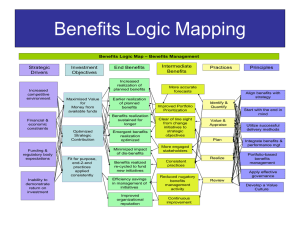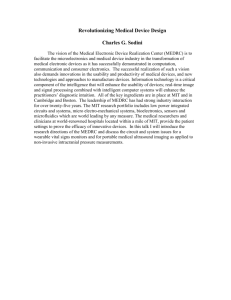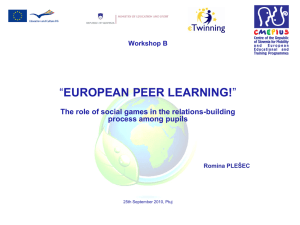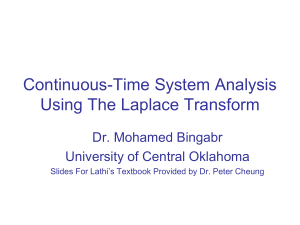Eurocast 2009 paper
advertisement
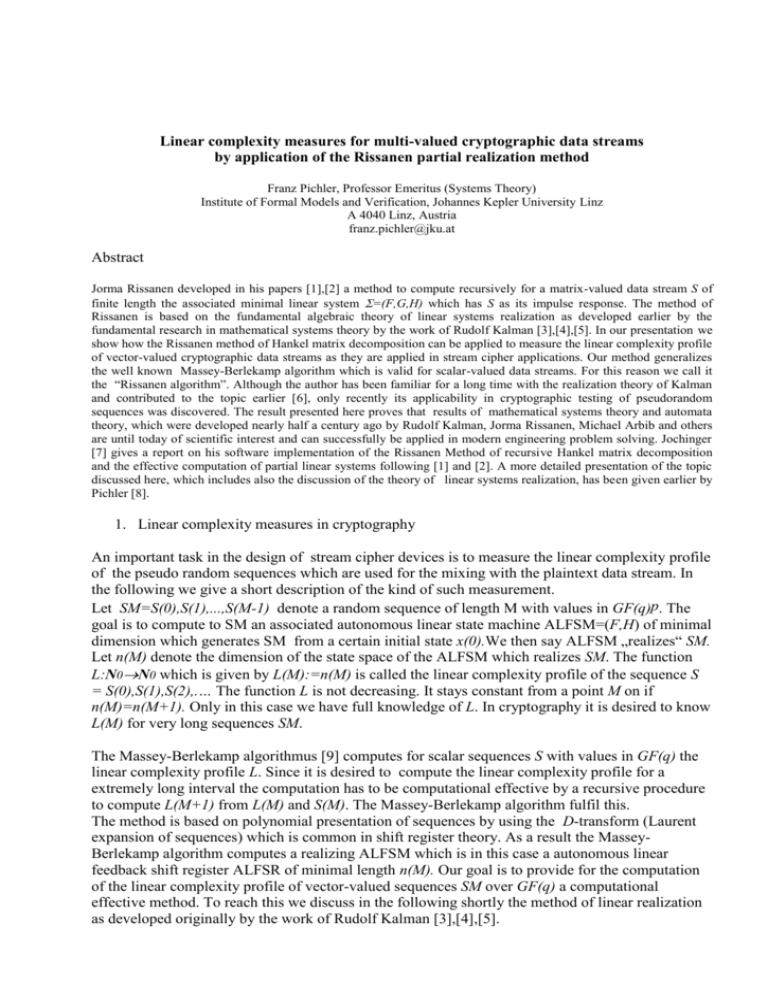
Linear complexity measures for multi-valued cryptographic data streams
by application of the Rissanen partial realization method
Franz Pichler, Professor Emeritus (Systems Theory)
Institute of Formal Models and Verification, Johannes Kepler University Linz
A 4040 Linz, Austria
franz.pichler@jku.at
Abstract
Jorma Rissanen developed in his papers [1],[2] a method to compute recursively for a matrix-valued data stream S of
finite length the associated minimal linear system =(F,G,H) which has S as its impulse response. The method of
Rissanen is based on the fundamental algebraic theory of linear systems realization as developed earlier by the
fundamental research in mathematical systems theory by the work of Rudolf Kalman [3],[4],[5]. In our presentation we
show how the Rissanen method of Hankel matrix decomposition can be applied to measure the linear complexity profile
of vector-valued cryptographic data streams as they are applied in stream cipher applications. Our method generalizes
the well known Massey-Berlekamp algorithm which is valid for scalar-valued data streams. For this reason we call it
the “Rissanen algorithm”. Although the author has been familiar for a long time with the realization theory of Kalman
and contributed to the topic earlier [6], only recently its applicability in cryptographic testing of pseudorandom
sequences was discovered. The result presented here proves that results of mathematical systems theory and automata
theory, which were developed nearly half a century ago by Rudolf Kalman, Jorma Rissanen, Michael Arbib and others
are until today of scientific interest and can successfully be applied in modern engineering problem solving. Jochinger
[7] gives a report on his software implementation of the Rissanen Method of recursive Hankel matrix decomposition
and the effective computation of partial linear systems following [1] and [2]. A more detailed presentation of the topic
discussed here, which includes also the discussion of the theory of linear systems realization, has been given earlier by
Pichler [8].
1. Linear complexity measures in cryptography
An important task in the design of stream cipher devices is to measure the linear complexity profile
of the pseudo random sequences which are used for the mixing with the plaintext data stream. In
the following we give a short description of the kind of such measurement.
Let SM=S(0),S(1),...,S(M-1) denote a random sequence of length M with values in GF(q)p. The
goal is to compute to SM an associated autonomous linear state machine ALFSM=(F,H) of minimal
dimension which generates SM from a certain initial state x(0).We then say ALFSM „realizes“ SM.
Let n(M) denote the dimension of the state space of the ALFSM which realizes SM. The function
L:N0N0 which is given by L(M):=n(M) is called the linear complexity profile of the sequence S
= S(0),S(1),S(2),.… The function L is not decreasing. It stays constant from a point M on if
n(M)=n(M+1). Only in this case we have full knowledge of L. In cryptography it is desired to know
L(M) for very long sequences SM.
The Massey-Berlekamp algorithmus [9] computes for scalar sequences S with values in GF(q) the
linear complexity profile L. Since it is desired to compute the linear complexity profile for a
extremely long interval the computation has to be computational effective by a recursive procedure
to compute L(M+1) from L(M) and S(M). The Massey-Berlekamp algorithm fulfil this.
The method is based on polynomial presentation of sequences by using the D-transform (Laurent
expansion of sequences) which is common in shift register theory. As a result the MasseyBerlekamp algorithm computes a realizing ALFSM which is in this case a autonomous linear
feedback shift register ALFSR of minimal length n(M). Our goal is to provide for the computation
of the linear complexity profile of vector-valued sequences SM over GF(q) a computational
effective method. To reach this we discuss in the following shortly the method of linear realization
as developed originally by the work of Rudolf Kalman [3],[4],[5].
2. Computation of Linear Systems Realizations
The algebraic theory of linear systems realizations deals with determination of a minimal linear
system =(F,G,H) for a given (observed) impulse response A:TM(pm).T denotes the time scale
and M(pm) is the set of matrices of size pm over a field K. The impulse response A can be
interpreted as a multiple I/O experiment on .
If T=R (continuous time) and K=R, is a linear differential system
if T=Z (discrete time) and K=R, is a linear difference system
if T=Z (discrete time),and K=GF(q), is a linear finite state machine LFSM
Our interest is the case of linear finite state machines LFSM=(F,G,H). In this case the impulse
response A of is given by A=A(0),A(1),... where A(k) are matrices with elements in GF(q).
It can be shown that the impulse response A of a discrete time linear system =(F,G,H) can
generally be expressed by
A=(HG,HFG,HF2G,HF3G, ... )
(1)
The linear system realization problem has the goal to determine (F,G,H) which meets equation (1)
To reach a solution of the linear realization problem we have to determine the state space Q of .
Let f: UY denote the „zero state“ I/O function of which assigns to each input function u with
finite support („input word“) the associated output function y=f(u) („output word“).Then the state
space Q of can be constructed by the quotient space
Q=U/ker(f)
(2)
3 Linear Partial Realizations
In case of the linear partial realization problem we have the task to determine =(F,G,H) which
generates a impulse response of finite length M which is given by
AM=(A(0),A(1),...,A(M-1))
(3)
In this case the I/O function f(N):U(N)Y(N) is restricted to the set U(N) of input functions u and
to the set Y(N) of output functions y of length N, respectively. The Hankel matrix H(N) of size NN
constructed with (3) shows the values f(N)(eik) of the I/O function f(N) for the set of basis vectors
eik (i=0,1,...,N-1, k=1,2,...,m) of U(N).
In this case the I/O function f(N):U(N)Y(N) is restricted to the set U(N) of input functions u
and to the set Y(N) of output functions y of length N, respectively . The Hankel matrix H(N) of size
NN constructed with (3) shows the values f(N)(eik) of the I/O function f(N) for the set of basis
vectors eik (i=0,1,...,N-1, k=1,2,...,m) of U(N).
A(0)
A(1)
H (N )
A( N 1)
A(1)
A(2)
A( N )
A(2)
A(3)
A( N 1)
A( N )
A( M 1)
(4)
It can be shown that the dimension n(M) of the state space Q of the LFSM which realizes AM can
be determined by n(M)=rank H(N) in case that we have rank H(N)=rank H(N+1)
In the following we give the steps which are necessary to compute a partial linear realization. We
follow the method which is discussed in the textbook of Padulo-Arbib [10]
Since Q=U(N)/ker(f(N)) we derive from rank H(N)=n the result Q=Kn
Let X={x1,x2,x3,...,xn} denote a basis for Q which we chose by taking n unit input functions
e1,e2,...,en which correspond to n linear independent rows f(ei) of H(N).For any input function u we
denote by [u] the representation of u by a column vector in the basis X. Then xi=[ei] for i=1,2,...,n.
It can be shown that the matrices F,G,H of the partial realization are given by
F= [[e10],[e20],...,[en0] ]
G= [[e1],[e2],...,[em]]
H= [f(N)(e1)(0),f(N)(e2)(0),...,f(N)(en)(0)]
(5)
(ei0 denotes the input function of length N+1 which is given by concatenation of ei with 0)
4. Determination of linear complexity measures by partial linear realization
The solution of the linear realization problem allows a solution of the cryptanalytic problem of
section 1 in the following way: For m=1 (scalar input) the finite length impulse response AM of a
LFSM is a vector-valued sequence AM=(A(0),A(1),...,A(M-1)) with A(k)GF(q)p which can be
interpreted as AM=SM. If =(F,G,H) is for AM the solution of the linear partial realization
problem then (F,H) generates from the initial state x(0)=Ge the finite length sequence SM as output
(e denotes the unit input word of length 1 which is given by e=1). Since G is in the case m=1 a
column vector of length n, we have x(0)=G1=G. We see that the application of the method of linear
partial realization determines for a given p-valued finite sequence SM the ALFSM=(F,H) and the
initial state x(0)=G of the ALFSM.
This result seems to be have been overlooked so far by the professional academic cryptologists. To
get this result it requires to know the result of Kalman´s realization theory and to consider the
(trivial) fact that the impulse response AM is defined only from time 1 on. By time-invariance of a
linear system and by the fact that =(F,G,H) operates with zero-input just as the corresponding
autonomous linear System ALFSM=(F,H) the above solution is clear.
5. Effective Computation of Linear Partial Realizations by the Method of Rissanen
Jorma Rissanen (IBM research CA and Stanford University, now with MDLResearch,Tampere,Finland, expert in „Statistical Modeling) developed in the late 1960´s for the
computation of partial realizations an effective method to compute recursively stepwise by the
length M of an observed impulse response AM the associated linear partial realization
M=(FM,GM,HM) and therefor also its dimension n(M).The computation of M+1 depends only
on the result M and the last value A(M) of AM+1. For the case of a scalar impulse response this
was shown by Rissanen in the paper [1]. For the more general matrix-valued case of impulse
response, that means for the case of multivariable I/O system , the paper [2] of Rissanen-Kailath
gives the method.
To the author no implementation of the Rissanen method was known or was available. Dominik
Jochinger implemented by the request of the author the method which is reported in [7]. Since the
application in cryptography was the main goal, the implementation was done for finite fields
K=GF(q) such that a computed linear system =(F,G,H) becomes a linear finite state machine
LFSM. Examples of computation prove the necessary effectiveness which is required for
determining linear complexity measures for stream cipher data. The Rissanen method will be
installed as a component of the existing “Crypto Workbench” of Dominik Jochinger and will serve
there for applications in cryptography.
6. Generalization of the Massey-Berlekamp Algorithm
Since the Rissanen method is computational effective, which compares to the Massey-Berlekamp
algorithm, we have found the appropriate method to apply linear systems realization for the
computation of the linear complexity profile L of a vector-valued random sequence
S=S(0),S(1),S(2),…. Therefor we want to call this method the Rissanen algorithm. With the
Rissanen algorithm we have found the generalization of the Massey-Berlekamp algorithm which
allows the effective computation of the linear complexity profile of vector-valued sequences of
data. The result has been reported in more detail in an earlier report[11] and paper [8].
7. Final Remarks
Modern cryptographic devices for fast stream cipher systems need pseudo random generators which
generate vector-valued ( Byte-oriented) sequences to be -mixed with the plain text data to get the
cipher text. For the determination of the linear complexity profile of the generated sequences in the
process of quality control the Rissanen algorithmus can be applied. As we have seen, the Rissanen
algorithm computes to a given vector-valued digital signal for „windows“ of length M (overlapping
or non-overlapping) an associated set of parameters which are given by the matrices F,G,H of the
linear system which allow a reconstruction of the signal by “running” . Further applications in
data compression, signal classification and data coding seem to be possible. Australian outbackpatents by Pichler-Kookaburra are in sincere consideration.
Of systems theoretical interest would be the determination of a basis for the state space Q of the
computed LFSM=(F,G,H) such that F becomes rational canonical form, which means that the
LFSM consists of a parallel composition of autonomous LFSR´s.
The result of this paper show that rather „classic“ topics of mathematical systems theory, such as
the „Algebraic Theory of Linear Systems“ as developed by Rudolf Kalman and others have after
nearly fifty years still the „power“ to lead to new applications of current interest.
The „linear realization method“, which is a part of the theory, was originally developed mainly for
applications in control theory. However, today this method seems to be rather neglected in
academic courses . I myself was interested in researching and teaching this topic some 30 years ago
[6],[12].
Only recently, by the opportunity of staying at Forresters Beach, Central Coast, Australia with the
support of my collaborator L. Kookaburra of Australia the here reported application could be
worked out. It should be mentioned that some authors proved by their work to come close to our
results. We mention the paper [13] which makes reference to realization theory however the authors
seem to have not seen the possibility of a generalization to vector-valued sequences. Jorma
Rissanen, when asked if he would know any current implementation of his realization method or
any application of it in cryptography denied this.
I thank Professor Jorma Rissanen,Tampere, Finland, for his interest in the paper and my former
student Dominik Jochinger for his cooperation in implementing the Rissanen method.
References
[1]
[2]
[3]
[4]
[5]
[6]
[7]
[8]
[9]
[10]
[11]
[12]
[13]
Rissanen, J.: Recursive Identification of Linear Systems
SIAM Journal on Control, Vol 9,No 3 August 1971, 420-430.
Rissanen,J, and T. Kailath : Partial Realization of Random Systems
Automatica, Vol. 8, Pergamon Press 1972, 389-396.
Kalman, R.E.: Mathematical description of linear dynamical systems.
SIAM Journal on Control, (1963), 152-192
Kalman, R.E. , P.L. Falb, M.A. Arbib : Topics in Mathematical Systems
Theory , chapter 10, Algebraic theory of linear systems,
McGraw Hill, New York 1969.
Ho, B.L. and R.E. Kalman: Effective construction of linear state-variable
models from input/output functions. Regelungstechnik,
Oldenbourg 1966, 545-548.
Pichler,F. : General Dynamical Systems: Construction and Realization.
In “Mathematical Systems Theory-Udine 1975”
Lecture Notes in Economics and Mathematical Systems,
Springer-Verlag Berlin 1976, 393- 408.
Jochinger,J. : A Software Implementation of the Rissanen Method for partial linear systems
realization. To be presented at EUROCAST 09, Las Palmas,February 2009.
Pichler,F. : Effective Computation of Cryptanalytic Measures for Stream Cipher Data by the
Rissanen Algorithmus. Revista de la Accademia.
Canaria de Ciences,XIX (Núms 1-2), 2007, pp. 9-22.
Massey J.:Shift register synthesis and BCH decoding. IEEE Trans on Information Theory
IT-15, 1967, 122-127
Padulo,L. and M.Arbib: System Theory. An Unified Approach to Continuous and Discrete
Systems. Hemisphere Publishing Corporation, Washington D.C.1974.
Pichler, F and L. Kookaburra: Forresters Beach Notes, Forresters Beach, Central Coast,
NSW, Australia, February 2008
Pichler, F : Realisierung linearer Input-Output Prozesse I: Diskrete Prozesse. Technischer
Bericht SYS-PED 1, Lehrkanzel für Systemtheorie, Universität Linz,
Dezember 1974, (in german,35 pages)
Jonckheere,E. and Chingwo Ma: A Simple Hankel Interpretation of the Massey-Berlekamp
Algorithm.Linear Algebra and its Applications, 1989, 65-76,



